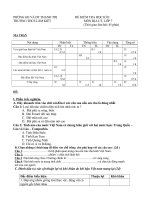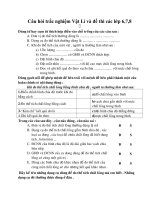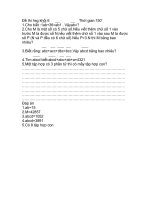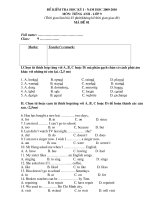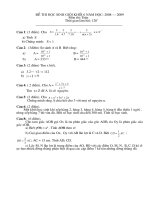Đề thi các khối 6 - 9 của Bình Dương
Bạn đang xem bản rút gọn của tài liệu. Xem và tải ngay bản đầy đủ của tài liệu tại đây (171.31 KB, 9 trang )
<span class='text_page_counter'>(1)</span><div class='page_container' data-page=1>
<b>Sở Giáo dục và Đào tạo tỉnh Bình Dương</b>
<b>KỲ THI TUYỂN SINH VÀO LỚP 10 - NĂM HỌC 2019-2020</b>
<b>ĐỀ THI MÔN TIẾNG ANH, ngày thi: 29/5/2019</b>
<b>Thời gian làm bài: Nghe (12 phút) + Đọc Viết (60 phút)</b>
Số báo danh:...Họ và tên học sinh:...
Họ tên và chữ ký Thầy/Cơ Giám thị 1:...
<b>THÍ SINH GHI CÂU TRẢ LỜI CỦA MÌNH TRÊN PHIẾU TRẢ LỜI.</b>
<b>(Thí sinh ghi các chữ cái (A, B, C... X, Y, Z) vào phiếu trả lời từ câu 1 đến câu 50.)</b>
<b>I. Listening (2.0 points):</b>
<i>Part 1: Questions 1-5: Listen to people talking about the things they cannot live without and </i>
<i>choose the correct answer (A, B, or C): You will hear the recording two times.</i>
<b>1</b>. The man says that____ <b>A</b>. he has had his phone for about six years.
<b>B</b>. he uses his phone to organise his social life.
<b>C. </b>he’s always calling people when they are lost.
<b>2</b>. The woman says that____ <b>A</b>. she has had her alarm clock for over a decade.
<b>B</b>. she had to wake her friends up in the morning.
<b>C. </b>she thinks studying at university is fantastic.
<b>3</b>. The man says that____ <b>A</b>. he has had his guitar for about twelve years.
<b>B</b>. he takes the guitar with him on holidays.
<b>C. </b>his guitar is old but it has really good sound.
<b>4</b>. The woman says that____ <b>A</b>. one thing she hates is her computer.
<b>B</b>. she uses the Internet quite a lot.
<b>C. </b>she communicates without e-mail.
<b>5</b>. The woman says that____ <b>A</b>. her dad gave her the ring as a birthday present.
<b>B</b>. she has had the ring for around thirteen years
<b>C</b>. she likes to hold the ring next to her heart.
<i><b>Part 2: Questions 5-10: Listen to people talking about the history of television and choose </b></i>
<i>the correct answer (F to W) for each question. You will hear the recording two times.</i>
<b>6</b>. When was TV invented? <b>F</b>. In 1920. <b>S. </b>In 1964.
<b>7</b>. When was color TV first developed? <b>G</b>. In 1926. <b>T</b>. In 1966.
<b>8</b>. When did America have its first all color TV channel?<b>H</b>. In 1940. <b>U. </b>In 1980.
<b>9</b>. When was cable TV first developed? <b>M</b>. In 1948. <b>V</b>. In 1986.
<b>10</b>. When was plasma TV first made? <b>R</b>. In 1960. <b>W. </b>In 1990.
<b>II. Reading ( 3.0 points):</b>
<i><b>Read the passage below carefully and fill in each blank with the best option A, B, C or D.</b></i>
<b>How To Improve English Speaking Skills</b>
Many students learn English grammar very well (<b>11</b>)_______cannot actually have a
conversation with native speakers. Here are a few tips for improving English speaking skills.
First of all, it is important to find native speakers to (<b>12</b>)_______with. Recording is
also a great way to get the maximum benefit from a conversation with a native speaker.
When you listen again, you can notice what you need to improve.
Another way is to watch movies or TV in English, with subtitles if you need them,
and watch the same programs over and over. (<b>13</b>)_______people find that they understand
more each time. Listening to music in English and singing (<b>14</b>)_______can also help you a
lot.
Reading out loud or talking to yourself is also a great way to practice speaking when
there are no conversation partners available. Practicing alone is a low-pressure way to
practice, since (<b>15</b>)_______will hear your mistakes.
<i>(Adapted from </i><i>)</i>
</div>
<span class='text_page_counter'>(2)</span><div class='page_container' data-page=2>
<b>12</b>. <b>A</b>. practice <b>B</b>. practical <b>C. </b>practically <b>D</b>. practicality
<b>13</b>. <b>A</b>. Most the <b>B</b>. The most <b>C</b>. Most <b>D</b>. Almost
<b>14</b>. <b>A</b>. after <b>B</b>. along <b>C. </b>behind <b>D</b>. beside
<b>15. A. </b>anybody <b>B</b>. somebody <b>C. </b>everybody <b>D</b>. nobody
<i><b>Read the passage below carefully and choose the best option A, B, C or D.</b></i>
The start of every New Year is when we make plans to change our life for the better
over the forthcoming twelve months. Psychiatry professor Jayashri Kulkarni says, “January
1st is a ‘magical’ date and a vow made on this day is much more powerful than one made on
June 1st<sub>, for example.” So, we make a list of things to quit, start or change. Unfortunately, </sub>
most of these promises are, more often than not, broken by January 31st<sub>. They are usually the </sub>
identical <b>resolutions</b> that were not fulfilled from the previous year, and the years prior to
that.
Researches show 45 percent of us make a New Year’s resolution. The most common
vows include losing weight, volunteering to help others, quitting smoking, saving money, and
getting fit. Others include eating healthier food, drinking less alcohol, and going on overseas
trips. However, researches also show that most of us are not so good at sticking to <b>these</b>. A
study from the University of Scranton reveals that 71 percent of us stick to our <b>annual</b>
promises for the first two weeks; six months later, less than 50 percent are still on track to
keep their resolutions. Most people who give up on their resolutions do so because of a lack
of willpower and the use of the ‘escape clause’ that they will ‘try again next year’.
<i>(Adapted from</i> )
<b>16</b>. What is the main idea of the passage?
<b>A</b>. People make a list of things to change on New Year’s Eve.
<b>B</b>. People have the willpower to change their life for the better.
<b>C. </b>People give up on their resolutions due to the lack of time.
<b>D</b>. People break their New Year’s resolutions years after years.
<b>17</b>. What does the word <b>“resolutions” </b>in paragraph 1 mean?
<b>A</b>. promises <b>B</b>. secrets <b>C. </b>lists <b>D</b>. activities
<b>18</b>. What does the word “<b>these</b>” in paragraph 2 refer to?
<b>A</b>. trips <b>B. </b>researches <b>C. </b>vows <b>D. </b>people
<b>19</b>. What does the word <b>“annual” </b>in paragraph 2 mean?
<b>A</b>. daily <b>B</b>. weekly <b>C. </b>monthly <b>D</b>. yearly
<b>20</b>. According to paragraph 2, how many of us make a New Year’s resolution?
<b>A</b>. Only a few of us <b>B</b>. About half of us <b>C. </b>Most of us <b>D</b>. All of us
<b>21</b>. According to paragraph 2, which of the following is NOT a popular vow?
<b>A</b>. Breaking bad habits <b>B</b>. Becoming healthier
<b>C</b>. Keeping a resolution <b>D</b>. Travelling abroad
<i><b>Read the passage below carefully and choose the best option A, B, C or D.</b></i>
Sloth was famous for being the laziest animal in the forest. He would eat and sleep all
day comfortably on the tree branches. All the other animals would be busy singing, playing
and looking for food and shelter but not Sloth. They told him, “You are a good for nothing.”
But Sloth just <b>ignored </b>them and carried on lazing around.
One day, a bird built her nest near Sloth’s branch. She laid her eggs and watched over
them until they hatched. Then, she had to fly off and look for food. She asked Sloth to keep
an eye on her babies. Sloth was too lazy to even answer. “You are good for nothing,” said the
bird angrily and flew off.
</div>
<span class='text_page_counter'>(3)</span><div class='page_container' data-page=3>
what Sloth did. <b>She </b>felt so ashamed of herself. “Sorry,” she said to Sloth. Sloth simply went
back to sleep.
<i>(Adapted from</i> http:// www.englishdaily626.com )
<b>22</b>. What does the word <b>“ignored” </b>in paragraph 1 mean?
<b>A</b>. paid no attention to <b>B</b>. looked forward to
<b>C. </b>paid compliments on <b>D. </b>looked up and down at
<b>23</b>. What did the mother bird want Sloth to do while she was away?
<b>A</b>. To keep his eyes open <b>B</b>. To watch her babies
<b>C. </b>To slither up the tree <b>D. </b>To look for food
<b>24</b>. What does the word <b>“She” </b>in paragraph 3 refer to?
<b>A</b>. The snake <b>B</b>. The baby bird <b>C. </b>Sloth <b>D</b>. The mother bird
<b>25</b>. What does the mother bird probably think at the end of the story?
<b>A</b>. “Sloth is really the laziest animal I have known.”
<b>B</b>. “Without the snake, my babies would not have died.”
<b>C. </b>“Sloth is not a good for nothing as many animals think.”
<b>D</b>. “I’ll never leave my children in the hands of Sloth again.”
<b>III. Communication and Phonetics (1.0 point):</b>
<i><b>Choose the questions and statements (F to Z) to complete the conversation between Ms Chef and a </b></i>
<i><b>shopkeeper. What did Ms Chef say? You only need five questions and statements for the blanks.</b></i>
<b>F</b>. Is it? Then that’s what I will have.
<b>G</b>. No, I think two types of vegetables are
enough.
<b>L</b>. Thank you. Now, let me have a look at
the vegetables.
<b>M</b>. That’s a fair price. Can I pay by credit
card?
<b>O. </b>That’s right.
<b>S. </b>Well, we have some important guests for
dinner tonight.
<b>W</b>. Yes please, and also some mushrooms.
<b>Z. </b>Yes, they do. What do you have?
<i>Shopkeeper:</i> Good morning Ms Chef.
<i>Ms Chef:</i> Good morning.
<i>Shopkeeper:</i> What can I do for you today?
<i>Ms Chef:</i> (<b>26</b>) ________
<i>Shopkeeper:</i> So you want something special?
<i>Ms Chef: </i>(<b>27</b>) ________
<i>Shopkeeper;</i> Do your guests like fish?
<i>Ms Chef:</i> (<b>28</b>) ________
<i>Shopkeeper:</i> I have a salmon. It’s very fresh and tasty.
<i>Ms Chef:</i> (<b>29</b>)________
<i>Shopkeepe:</i> Here you are then.
<i>Ms Chef: </i>(<b>30</b>)________
<i><b>Choose the word whose Underlined part differs from the other three words in pronunciation in each </b></i>
<i><b>of the following questions.</b></i>
<b>31</b>. <b>A</b>. imagin<b>ed</b> <b>B. </b>consider<b>ed</b> <b>C. </b>moderniz<b>ed</b> <b>D. </b>develop<b>ed</b>
<b>32</b>. <b>A</b>. subject<b>s</b> <b>B</b>. design<b>s</b> <b>C. </b>standard<b>s</b> <b>D</b>. label<b>s</b>
<b>33</b>. <b>A</b>. tr<b>ea</b>sure <b>B</b>. f<b>ea</b>ture <b>C. </b>l<b>ea</b>ther <b>D</b>. w<b>ea</b>ther
<i><b>Choose the word which differs from the other three words in the position of the primary stress in </b></i>
<i><b>each of the following questions.</b></i>
34. <b>A</b>. terrific <b>B. </b>effective <b>C. </b>marvelous <b>D. </b>impressive
35. <b>A</b>. persuade <b>B. </b>install <b>C. </b>occur <b>D. </b>capture
<b>IV. Vocabulary and Grammar (1.5 points): Choose the best option A. B. C or D. </b>
<b>36</b>. Tornadoes <b>mostly</b> happen during very strong thunderstorms and cause a lot of damage to
anything they touch. The <b>SYNONYM </b>of <b>“mostly” </b>is ______ .
<b>A. </b>never <b>B. </b>seldom <b>C. </b>usually <b>D. </b>always
<b>37</b>. Komodo dragons are <b>huge </b>reptiles that can grow to three meters long and weigh 160
kilos. The <b>ANTONYM</b> of <b>“huge” </b>is ______.
<b>A. </b>little <b>B. </b>violent <b>C. </b>impressive <b>D. </b>complicated
<b>38</b>. Find a <b>mistake</b> in one of the four underlined parts of the following sentence.
I asked my pen pals if they could speak other foreign languages beside English.
</div>
<span class='text_page_counter'>(4)</span><div class='page_container' data-page=4>
<b>39</b>. Thank you very much for your present. The chocolate tastes so ______.
<b>A. </b>lovely <b>B</b>. greatly <b>C. </b>sweetly <b>D</b>. deliciously
<b>40</b>. Everybody was here yesterday, ______?
<b>A</b>. wasn’t anybody <b>B</b>. wasn’t nobody <b>C</b>. weren’t they <b>D</b>. weren’t he and she
<b>41</b>. Children need lots of______from their parents.
<b>A</b>. encourage <b>B</b>. encouragement <b>C</b>. courageous <b>D</b>. discourage
<b>42</b>. Of the two children, Helen and Alice, Helen is the ______
<b>A</b>. funny <b>B</b>. funnier <b>C</b>. funniest <b>D</b>. most funny
<b>43</b>. Hawaii, ______consists of eight principal islands, is a favorite vacation spot.
<b>A</b>. where <b>B</b>. that <b>C</b>. which <b>D</b>. it
<b>44</b>. I wish she______me with the housework but she is so busy with her homework.
<b>A</b>. can help <b>B</b>. can’t help <b>C</b>. could help <b>D</b>. couldn’t help
<b>45</b>. My friends practiced very hard; ______, they won the championship.
<b>A</b>. since <b>B</b>. although <b>C</b>. however <b>D</b>. therefore
<b>46</b>. The Japanese school year normally begins______April and ends the following March.
<b>A</b>. in <b>B</b>. on <b>C</b>. between <b>D</b>. from
<b>47</b>. You cannot make people______if they don’t want to.
<b>A</b>. stay <b>B</b>. staying <b>C</b>. to stay <b>D</b>. to staying
<b>48</b>. Professor Luke, to whom he apologized _____ not paying attention in class, is my teacher.
<b>A</b>. to <b>B</b>. for <b>C</b>. about <b>D</b>. with
<b>49</b>. The key______a football match is lots of practice and confidence.
<b>A</b>. winning <b>B</b>. to be won <b>C</b>. to winning <b>D</b>. to being won
<b>50</b>. Different ways ______many kinds of cheeses and the cheese is then pressed into different
shapes.
<b>A</b>. are used to producing <b>B</b>. used to be produced
<b>C</b>. are used to produce <b>D</b>. used to produce
<b>V. Writing:</b>
<b>Lưu ý:- Thí sinh KHƠNG chép lại đề vào phiếu trả lời.</b>
<b>- Thí sinh KHƠNG ghi thơng tin cá nhân vào bài viết.</b>
<b>Part 1: Sentence transformation (0.5 point):</b>
<i>Complete the second sentence so that it has a similar meaning to the first sentence, using the word in </i>
<i>brackets. Do not change the word given. You must use FIVE WORDS, INCLUDING THE WORD </i>
<i>GIVEN. Only write the five words on your answer sheet. Long answers will NOT be marked.</i>
<i><b>Example 1</b></i><b>:</b>Chicago is a big city, but Los Angeles is bigger. (<b>not</b>) <i>→</i> Chicago ___ Los Angeles.
<i><b>Answer 1:</b></i> is not as big as
<i><b>Example 2:</b></i>It’s a pity Hoa doesn’t have a flower garden. (<b>had</b>) <i>→</i> Hoa wishes that _____.
<i><b>Answer 2:</b></i> she had a flower garden
<b>51</b>. James asked, “Will you work tomorrow, Lily?” (<b>following</b>)
<i>→ </i>James wanted to know if __________________ day.
<b>52</b>. He couldn’t drink the tea. It was too hot. (<b>to</b>)
<i>→</i> The tea was too ____________________
<b>53</b>. People speak English around the world. (<b>over</b>)
<i>→ </i>English ___________________________ world.
<b>54</b>. Keep the environment clean or we won’t enjoy a healthy life. (<b>pollute</b>)
<i>→ </i>We won’t enjoy a healthy life___________________________
<b>55</b>. I don’t know how to get to the station. (<b>way</b>)
→ I wish I ___________________________ station.
<b>Part 2: Paragraph writing (2 points):</b>
<i>What is the most useful device that has been invented sin the last 100 years? Write a paragraph </i>
<i>(80-120 words) about this device and give three reasons why you think it is the most useful device.</i>
</div>
<span class='text_page_counter'>(5)</span><div class='page_container' data-page=5>
---SỞ GDĐT BÌNH DƯƠNG CỘNG HỒ XÃ HỘI CHỦ NGHĨA VIỆT NAM
Tổ chấm Tiếng Anh 10 Độc lập - Tự do - Hạnh phúc
<b>BIÊN BẢN THỐNG NHẤT ĐÁP ÁN VÀ HƯỚNG DẪN CHẤM THI TUYỂN SINH 10</b>
<b>MÔN TIẾNG ANH - Năm học 2019-2020</b>
<b>Thời gian</b>: 7 giờ 30 ngày 03 tháng 6 năm 2019
<b>Địa điểm</b>: Hội trường trường tiểu học Phú Lợi
Thành phần: Cơ Nguyễn Minh Trúc Tâm - Phó Chủ tịch
Cô Lê Thị Minh Nhựt - Tổ trưởng
Cô Vũ Minh Thanh Bình - Tổ phó tổ 1
Cơ Lợi Tú Linh - Tổ phó tổ 2
Cơ Tơ Thị Kiều Oanh - Tổ phó tổ 3
Cơ Phạm Thanh Hiền - Tổ phó tổ 4
Cùng 120 giám khảo chấm tuyển sinh 10 và các giám khảo chấm kiểm tra
<b>Nội dung</b>: Thống nhất đáp án và hướng dẫn chấm thi tuyển sinh 10. Cụ thể như sau:
<b>I. Listening: </b>Questions 1-10 (2 điểm): <b>0.2</b> điểm cho mỗi câu đúng
<b>II. Reading</b>: Questions 11-25 (3 điểm): <b>0.2</b> điểm cho mỗi câu đúng
<b>III. Communication and Phonetics</b>: Questions 26-35 (1 điểm): <b>0.1</b> điểm cho mỗi câu đúng
<b>IV. Vocabulary and Grammar:</b> Question 36-50 (1.5 điểm): <b>0.1</b> điểm cho mỗi câu đúng
* Giám khảo chấm lần 1 <b>gạch dọc</b> để khoá bài những câu học sinh bỏ trống
<b>V. Writing: (2.5</b> điểm)
<b>Part 1</b>: Question 51-55 (<b>0.5</b> điểm): 0.1 điểm cho mỗi câu đúng
* Chấm theo yêu cầu của đề: 5 từ theo 5 đáp án
* Nếu học sinh ghi dư 1 từ cuối của câu 51, 53, 55: chấm 5 từ theo đáp án và từ cuối đó
+ <b>Q51</b>: Lily would work the following (day)
+ <b>Q53</b>: is spoken all over the (world)
+ <b>Q55</b>: knew the way to the (station)
* Nếu học sinh viết lại cả câu mà chính xác hồn tồn thì vẫn chấm 0.1 cho mỗi câu đúng
* Giám khảo chấm lần 2: gạch dưới 5 từ trong câu viết lại nếu cả câu đó chính xác
+ <b>Q51</b>: James wanted to know if <b>Lily would work the following</b> (day)
+ <b>Q52</b>: The tea was too hot <b>for him to drink</b>
+ <b>Q53</b>: English <b>is spoken all over the</b> world
+ <b>Q54</b>: We won’t enjoy a healthy life <b>if we pollute the environment</b>
+ <b>Q55</b>: I wish I <b>knew the way to the</b> station
* Giám khảo chấm <b>lần 1gạch dọc</b> để khoá bài những câu mà học sinh bỏ trống
* Giám khảo chấm <b>lần 2 đánh dấu X</b> ở cuối những câu mà học sinh viết sai, khơng cần
đánh dấu gì khác vào các chỗ sai trong câu viết lại
<b>Part 2</b>: Paragraph writing
* <b>Device (thiết bị, dụng cụ, máy móc)</b>: phải là vật hữu hình, hữu dụng (<i>nếu là phát minh</i>
<i>khơng phổ biến thì phát minh đó phải có tính sáng tạo, độc đáo</i>), và phải là vật đã được
phát minh (khơng tính mốc thời gian nào trong quá khứ).
* Bài viết lạc đề, 0 điểm, nếu học sinh viết về Youtube, Internet, Facebook, Instagram,
Twitter, các trang mạng xã hội, các website, phần mềm, ứng dụng trên điện thoại...
* Bài viết lạc đề, 0 điểm, nếu học sinh viết bài mà không nêu được tên thiết bị.
* Học sinh viết sai chính tả hoặc thiếu mạo từ: tính theo lỗi từ vựng.
* Phần viết có số lượng từ 75 từ trở lên: tối đa 2.0 điểm
<b>1. Task achievement and content: 0.8 điểm</b>
</div>
<span class='text_page_counter'>(6)</span><div class='page_container' data-page=6>
* Học sinh nêu được 3 lý do, mỗi lý do 1 điểm
* Học sinh nêu được 3 lý giải / ý phát triển, mỗi lý giải 0.1 điểm
* Học sinh có thể viết từ 1 đến nhiều câu cho mỗi lý do và lý giải
<b>2. Organization: 0.4 điểm</b>
* Học sinh viết đúng hình thức đoạn văn (có từ 3 câu trở lên): 0.2 điểm
* Học sinh sử dụng từ nối: 2 từ nối được 0.1 điểm, từ 3 từ trở lên: 0.2 điểm (<i>first, firstly, </i>
<i>second, secondly, and, or, but, so, such as, for example...)</i>
* Học sinh sử dụng các từ first, second, third không nhất quán (first, secondly, third hoặc
firstly, second, thirdly): tính 1 lỗi từ vựng. Nếu viết sai chính tả thì tính thêm lỗi chính tả.
<b>3. Language: Variety + Vocabulary and grammar = 0.8 điểm</b>
Variety (<b>0.2</b>)
* Học sinh sử dụng nhiều loại câu (câu đơn, câu ghép, câu phức...): <b>0.1</b> điểm
* Học sinh sử dụng từ một cách tự nhiên, không lặp từ, không viết lủng củng: <b>0.1</b>
điểm
Vocabulary and grammar (<b>0.6</b>)
* Học sinh có 3 lỗi trở xuống: 0.6 điểm
* Học sinh có 4 lỗi: 0.5 điểm
* Học sinh có 5, 6 lỗi: 0.4 điểm
* Học sinh có 7, 8 lỗi: 0.3 điểm
* Học sinh có 9, 10 lỗi: 0.2 điểm
* Học sinh có 11, 12 lỗi: 0.1 điểm
* Học sinh có 13, 14 lỗi: 0 điểm phần vocabulary and grammar
Học sinh có 15 lỗi trở lên: 0 điểm phần <b>Language</b> (khơng xét điểm Variety nữa)
<b> Phần viết có số lượng 50-74 từ: tối đa 1.2 điểm</b>
1. Task achievement and content: <b>0.5 </b>điểm (device 0.1 + lý do 0.2 + lý giải 0.2)
2. Organization: <b>0.2</b> điểm (paragraph 0.1, khơng tính cohesive device(s) 0.1)
3. Language: <b>0.5</b> điểm (variety 0.1 + Voc Gram 0.4)
* Học sinh có 1, 2 lỗi: 0.3 điểm
* Học sinh có 3, 4 lỗi: 0.2 điểm
* Học sinh có 5, 6 lỗi: 0.1 điểm
* Học sinh có 7, 8 lỗi: 0 điểm
Học sinh có từ 9 lỗi trở lên: 0 điểm phần Language
<b> Phần viết có số lượng dưới 50 từ: tối đa 0.5 điểm</b>
1. Task achievement and content: <b>0.2</b> điểm (device 0.1 + lý do / lý giải 0.1)
2. Organization: 0.1 điểm (paragraph 0.1, không tính cohesive devices)
3. Language: Voc Gram <b>0.2</b> điểm (khơng tính điểm variety)
* Học sinh có 1, 2 lỗi: 0.1 điểm
* Học sinh có từ 3 lỗi: 0 điểm
<i>Thủ Dầu Một, ngày 03 tháng 6 năm 2019</i>
<b>Thư ký</b> <b>Tổ trưởng</b> <b>Phó chủ tịch</b>
</div>
<span class='text_page_counter'>(7)</span><div class='page_container' data-page=7>
SỞ GDĐT BÌNH DƯƠNG CỘNG HỒ XÃ HỘI CHỦ NGHĨA VIỆT NAM
Tổ chấm Tiếng Anh 10 Độc lập - Tự do - Hạnh phúc
<b>KỲ THI TUYỂN SINH VÀO LỚP 10 - NĂM 2019</b>
<b>HƯỚNG DẪN CHẤM MÔN TIẾNG ANH</b>
<b>+ Questions 01 to 25: 25 x 0.2 = 5.0 points</b>
<b>+ Questions 26 to 50: 25 x 0.1 = 2.5 points</b>
<b>Listening</b> <b>Reading</b>
1. B 6. G 11. B 16. D 21. C
2. A 7. H 12. A 17. A 22. A
3. C 8. T 13. C 18. C 23. B
4. B 9. M 14. B 19. D 24. D
5. A 10. S 15. D 20. B 25. C
<b>Communication and Phonetics</b> <b>Vocabulary and Grammar</b>
26. S 31. D 36. C 41. B 46. A
27. O 32. A 37. A 42. B 47. A
28. Z 33. B 38. D 43. C 48. B
29. F 34. C 39. A 44. C 49. C
30. L 35. D 40. C 45. D 50. C
<b>Question 51 to 55: 05 x 0.1 = 0.5 point.</b><i>No point is given for answers with more than 5 </i>
<i>words.</i>
<b>51</b>. Lily would work the following
<b>52</b>. hot for him to drink
<b>53</b>. is spoken all over the
<b>54</b>. if we pollute the environment
<b>55</b>. knew the way to the
<i><b>Paragraph writing (2 points): What is the most useful device that has been invented in the </b></i>
<i>last 100 years? Write a paragraph (80 - 120 words) about this device and give three reasons </i>
<i>why you think it is the most useful device.</i>
<b>+ Guidelines for pieces of writing that have more than 79 words</b>
<b>Task achievement and Content: 0.8 point</b>
(0.2) Name the most useful device
(0.3) Give 3 reasons
(0.3) Have supporting details and/or examples for each reason
<b>Organization: 0.4 point</b>
(0.2) Have the format paragraph
(0.2) Appropriately use a range of cohesive devices (2 cohesive devices = 0.1 point)
<b>Language: 0.8 point</b>
(0.2) Use a wide range of vocabulary and structures
(0.6) Have up to 3 lexical and/or grammar errors
<i>(2 errors → loses 0.1 point; 16 errors → loses all 0.8 point of Language)</i>
<b>+ Note for writing:</b>
Definition of “<b>device</b>”: <i>an object, a tool or a machine that has been invented for a </i>
<i>particular purpose</i>
Students will have 0 point if their writing is <b>OFF TOPIC</b>
The guideline below are for writing of fewer than 80 words.
</div>
<span class='text_page_counter'>(8)</span><div class='page_container' data-page=8>
Organization:
Language:
<i>(2 errors → loses 0.1 point)</i>
0.1 + 0.1 = 0.2
0.1 + 0.4 = 0.5
<i>(Has up to 2 errors)</i>
0.1 + 0.0 = 0.1
0.0 + 0.2 = 0.2
<i>(Has up to 1 error)</i>
<b>Listening script:</b>
<b>Part I:</b>
1. I couldn’t live without my mobile phone.
I've had this phone for about six months
now and I use it to organise my social life,
I’m always sending texts and calling people
when I'm out and about. I'd be really lost
without it.
2. One thing I couldn't live without is my
alarm clock. I've had it for about twelve
years now and it was given to me by friends
at university because I just couldn't get up in
the morning. Um... it's battery-operated and
It’s actually in the shape of a soldier and he
has a helmet and to turn the alarm off. you
have to press down his helmet which I think
is fantastic.
3. One thing I'd hate to be without is my
guitar. I have had it for over twenty years,
and I play it most days and sometimes when
I go on holiday I don’t take it with me and
after about two days I’m wishing I had. It’s
old, but it’s got a really good sound... and I
love it.
4. One thing I hate to be without is my
computer. I don’t remember what life was
like before. I use the internet quite a lot and
I e-mail friends and family and I don’t know
if I could write a letter and communicate
with them without e-mail.
5. One thing I’d hate to be without is my
ring. It was given to me by my dad as a
birthday present when I was around thirteen
years old and um... I don’t think I’ve
actually taken it off since. It’s made of
silver and it has a heart in the middle of it
and two hands which are kind of holding the
heart.
<b>Part 2:</b>
A: Now, I know you're all here to study TV
electronics. But first, before we learn how
TVs work and how to fix them, let's first
have a look at the history of television. All
right? So, when do you think TV was
invented?
B: I guess it was some time in the 1960s?
A: Actually, the history of television goes
back to the 1920s when a Scottish engineer
called Win Baird developed a system for
sending images. He had the first
demonstration of TV in 1926.
B: 1926? That's amazing. Was it in color?
A: No, in black and white, of course. So
when do you think color started appearing?
C: It was probably around 1980.
A: Oh, much earlier than that, actually.
Color TV was first developed in 1940 by
Peter Goldmark, and by 1966, America had
its first all color TV channel. And speaking
of TV channels. When do you think cable
was first developed?
D: I think it was around 1960.
A: Again, much earlier. Cable TV was
developed in 1948, at first for people who
lived in remote areas and had difficulty
receiving TV signals. Yes? Another
question?
B: What about plasma TVs?
A: Yes, well we’re coming to that. Do you
have one?
C: Yes, I do!
A: And when do you think plasma TVs
were first made?
D: Oh, I’m not sure... It must have been in
the 90s.
</div>
<span class='text_page_counter'>(9)</span><div class='page_container' data-page=9></div>
<!--links-->
<a href='j/'> </a>



